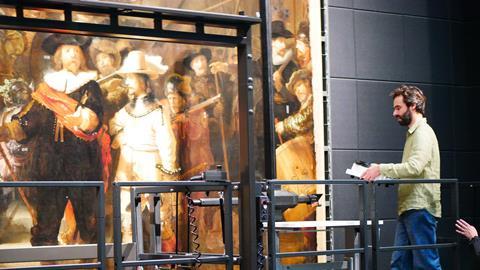For two weeks, a hand-held Laser Speckle Imaging device analysed The Night Watch from just a few centimetres away. This project marks the transition from research to restoration of the famous painting.
About two years ago, we wrote about a ‘modified medical technique’ (Laser Speckle Imaging) that Wageningen researchers used to peer into the exciting world of drying paint. This technique has now come of age within the start-up company NanoMoi, founded by CEO Jesse Buijs. As proof of the practical potential of the technique, an extensive analysis of the painting Militia Company of District II under the Command of Captain Frans Banninck Cocq, ‘The Night Watch’, has just been carried out, with the aim of making a scientifically sound decision on cleaning methods.
‘You can see this as the end product of our research’, says Buijs, who spent half a PhD and two post-docs on the project. ‘In the last few years, we have mainly focused on what you can measure, what happens to the paint and how it interacts with solvents. Then we slowly moved on to real paintings.’
More recently, the focus has been on making a portable setup and automating the data analysis, but practical implications have also come into play. Buijs: ‘How does a conservator use the technology? How do we make sure the instrument is not in the way? Which tests are interesting and which ones do you need to reach a conclusion? All this research ultimately leads to a recommendation on the best way to clean.’
Varnish
‘It’s just really cool’, says Buijs, seeing his work applied to the most famous painting in the Netherlands. ‘The fact that we were able to take measurements from a few centimetres away, that we were working with it in front of visitors and that it is so famous, makes it a very special experience’, he states.
Buijs cannot (yet) reveal details and results of the research, but based on previous analyses of other paintings, he explains that you can, for example, look at the varnish layers. ‘The fully covering layer of varnish was sometimes applied over a previous layer of varnish that had not been completely removed during a prior restoration’, says Buijs. ‘You don’t want to keep removing it, so we looked at which solvent would remove both layers at once.’
It seems counterintuitive, but it turns out that cleaning with a more aggressive solvent has less of an impact. ‘You finish faster and therefore use less solvent’, says Buijs. ‘These are results that conservators are happy with. But it is not universal; paintings are so incredibly complex. In my opinion, you have to measure a lot to be able to say anything concrete about a cleaning technique.’
Confidence
With the information from the NanoMoi measurements, it is therefore possible to say something about which solvent is best, what its effects are, whether and how it spreads over the painting, and what the best method of application is. Buijs: ‘This way you can offer tailor-made solutions for each painting, because depending on the size you can also see differences within the same painting. We back up our decisions with data, so you can find a balance between good cleaning and gentle cleaning.’
Buijs and his colleagues randomly tested the painting in a number of different areas to get an idea of its diversity. Now that they have done that, it is time to analyse the data, which will be used by the conservators to make their decisions. With his business in mind, Buijs is already looking ahead to other paintings. We will continue with the Rijksmuseum, of course, but I also hope that my technique will be adopted by other museums. That is why I am happy with this project and the faith of the Rijksmuseum: if you can analyse The Night Watch, NanoMoi must be a reliable and safe technique.’













Nog geen opmerkingen